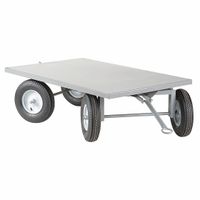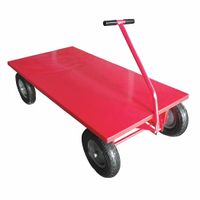Call +(254) 703 030 000 / 751 483 999 / 721 704 777
- Home
- Material Handling
- Transporting
- Carts Trucks
- Wagon Trucks Trailers
.....Read More
Frequently Asked Questions
What is the difference between a wagon truck and a trailer?
A wagon truck and a trailer are both used for transporting goods, but they differ in structure and function.
A wagon truck, often referred to simply as a truck, is a self-contained vehicle with an engine, cab, and cargo area all on a single chassis. It is designed to carry goods without the need for an additional towing vehicle. Wagon trucks are versatile and can be used for various types of cargo, depending on their size and configuration. They are ideal for short to medium distances and are commonly used for local deliveries.
A trailer, on the other hand, is an unpowered vehicle that is towed by a powered vehicle, such as a truck or tractor. Trailers come in various types and sizes, including flatbeds, refrigerated trailers, and tankers, each designed for specific types of cargo. The primary advantage of using a trailer is its ability to carry larger loads than a wagon truck, as the towing vehicle can be detached and used with different trailers. This flexibility makes trailers suitable for long-haul transportation and specialized cargo.
In summary, the main differences lie in their structure and usage: a wagon truck is a single, self-contained unit, while a trailer requires a separate towing vehicle. Wagon trucks are more suited for local deliveries, whereas trailers are ideal for long-distance and heavy or specialized cargo transport.
How do you choose the right wagon truck or trailer for your needs?
1. **Purpose and Load Requirements**: Determine the primary use (e.g., transporting livestock, equipment, or goods) and the weight and size of the load. This will guide the size and type of trailer or truck needed.
2. **Capacity and Size**: Choose a trailer or truck with adequate capacity. Consider the gross vehicle weight rating (GVWR) and ensure it can handle your load safely.
3. **Type of Trailer or Truck**: Select the appropriate type, such as flatbed, enclosed, utility, or livestock trailers, based on your specific needs.
4. **Towing Vehicle Compatibility**: Ensure your towing vehicle can handle the trailer's weight. Check the vehicle’s towing capacity and hitch compatibility.
5. **Material and Durability**: Consider the construction material (steel, aluminum) for durability and maintenance. Aluminum is lighter and rust-resistant, while steel is stronger but heavier.
6. **Braking System**: Ensure the trailer has a reliable braking system, especially for heavy loads. Electric brakes are common and effective.
7. **Axles and Suspension**: Choose the right number of axles and a suitable suspension system for stability and smooth transport.
8. **Budget and Cost**: Consider your budget, including purchase price, maintenance, and operational costs. Balance cost with quality and features.
9. **Legal Requirements**: Check local regulations for licensing, permits, and safety standards to ensure compliance.
10. **Additional Features**: Look for features like ramps, tie-down points, and storage compartments that enhance functionality.
11. **Brand and Dealer Reputation**: Research brands and dealers for reliability, customer service, and warranty options.
12. **Resale Value**: Consider the potential resale value if you plan to upgrade in the future.
What are the weight limits for wagon trucks and trailers?
The weight limits for wagon trucks and trailers vary by country and region, but generally adhere to specific regulations to ensure road safety and infrastructure protection. In the United States, the Federal Highway Administration (FHWA) sets the maximum weight limits under the Federal Bridge Formula. The standard limits are:
1. **Single Axle**: 20,000 pounds
2. **Tandem Axle**: 34,000 pounds
3. **Gross Vehicle Weight (GVW)**: 80,000 pounds
These limits can be subject to state-specific regulations, which may allow for higher weights on non-interstate roads. Some states have special permits for heavier loads, often requiring additional fees and route restrictions.
In the European Union, the maximum weight limits are generally:
1. **Single Axle**: 11.5 metric tonnes (approximately 25,353 pounds)
2. **Tandem Axle**: 18 metric tonnes (approximately 39,683 pounds)
3. **Gross Vehicle Weight (GVW)**: 40 metric tonnes (approximately 88,185 pounds) for standard vehicles, with some exceptions allowing up to 44 metric tonnes (approximately 97,003 pounds) for certain types of transport, like intermodal containers.
In Australia, the National Heavy Vehicle Regulator (NHVR) governs weight limits, with the following general limits:
1. **Single Axle**: 6.0 to 7.0 tonnes (approximately 13,228 to 15,432 pounds) depending on the type of axle and tires
2. **Tandem Axle**: 16.5 to 20.0 tonnes (approximately 36,376 to 44,092 pounds)
3. **Gross Vehicle Weight (GVW)**: Up to 42.5 tonnes (approximately 93,696 pounds) for general access vehicles, with higher limits for specific configurations under the Performance-Based Standards (PBS) scheme.
These regulations are crucial for maintaining road safety and minimizing wear and tear on infrastructure. Compliance is typically enforced through weigh stations and roadside inspections.
How do you maintain and care for wagon trucks and trailers?
Regular maintenance and care for wagon trucks and trailers are crucial for safety, efficiency, and longevity. Here are key steps:
1. **Inspection**: Conduct pre-trip and post-trip inspections. Check for visible damage, tire condition, lights, brakes, and fluid levels.
2. **Tire Maintenance**: Regularly check tire pressure and tread depth. Rotate tires and align wheels to prevent uneven wear.
3. **Brake System**: Inspect brake pads, rotors, and fluid levels. Replace worn components promptly to ensure effective braking.
4. **Lubrication**: Regularly lubricate moving parts such as hinges, joints, and suspension components to reduce friction and wear.
5. **Fluid Checks**: Monitor and top up engine oil, coolant, transmission fluid, and hydraulic fluids. Change fluids as per manufacturer recommendations.
6. **Electrical System**: Check battery health, wiring, and connections. Ensure all lights and signals are functioning properly.
7. **Body and Frame**: Inspect for rust, corrosion, and structural damage. Repair or replace damaged parts to maintain integrity.
8. **Suspension and Axles**: Regularly inspect for wear and damage. Ensure proper alignment and replace worn components.
9. **Cleaning**: Keep the exterior and interior clean to prevent rust and maintain a professional appearance.
10. **Documentation**: Maintain detailed records of inspections, repairs, and maintenance activities for compliance and tracking.
11. **Professional Servicing**: Schedule regular professional servicing for comprehensive checks and maintenance.
12. **Load Management**: Ensure proper loading and weight distribution to prevent undue stress on the vehicle.
13. **Driver Training**: Train drivers on proper handling and reporting of issues to prevent misuse and ensure timely maintenance.
By following these steps, you can ensure the reliability and safety of wagon trucks and trailers.
Can wagon trucks and trailers be used on rough terrain?
Yes, wagon trucks and trailers can be used on rough terrain, but their effectiveness depends on several factors.
1. **Design and Build**: Off-road or all-terrain wagon trucks and trailers are specifically designed for rough terrain. They feature reinforced frames, higher ground clearance, and robust suspension systems to handle uneven surfaces.
2. **Tires**: The type of tires is crucial. Off-road tires with deep treads provide better traction on loose or uneven surfaces like mud, sand, or gravel.
3. **Weight Distribution**: Proper weight distribution is essential to maintain stability on rough terrain. Overloading or uneven loading can lead to tipping or loss of control.
4. **Power and Torque**: Vehicles with higher power and torque are better suited for rough terrain as they can handle steep inclines and obstacles more effectively.
5. **Four-Wheel Drive (4WD) or All-Wheel Drive (AWD)**: These systems provide better traction and control on rough terrain compared to two-wheel drive systems.
6. **Durability and Maintenance**: Regular maintenance and durable construction materials help withstand the wear and tear of rough terrain.
7. **Driver Skill**: Experienced drivers can navigate rough terrain more effectively, understanding how to maneuver around obstacles and when to apply power.
8. **Environmental Considerations**: Some terrains may be too challenging or environmentally sensitive, requiring specialized equipment or techniques.
In summary, while standard wagon trucks and trailers may struggle on rough terrain, those designed for off-road use, equipped with the right features, and operated by skilled drivers can perform effectively.
What are the best brands for wagon trucks and trailers?
Some of the best brands for wagon trucks and trailers include:
1. **Ford**: Known for its durability and performance, Ford offers a range of trucks like the F-Series, which are popular for towing and hauling.
2. **Chevrolet/GMC**: These brands, under General Motors, provide reliable trucks such as the Silverado and Sierra, known for their strong towing capabilities and comfort.
3. **Ram**: Ram trucks are renowned for their powerful engines and luxurious interiors, making them a favorite for both work and leisure.
4. **Toyota**: The Toyota Tundra and Tacoma are celebrated for their reliability and off-road capabilities, making them excellent choices for towing and hauling.
5. **Nissan**: The Nissan Titan offers a good balance of power and comfort, with a reputation for reliability.
6. **Kenworth**: For heavy-duty needs, Kenworth trucks are known for their durability and advanced technology, making them a top choice in the commercial sector.
7. **Peterbilt**: Another leader in heavy-duty trucks, Peterbilt is praised for its robust construction and driver comfort.
8. **Freightliner**: Known for innovation and efficiency, Freightliner trucks are a staple in the commercial trucking industry.
9. **Great Dane**: In the trailer segment, Great Dane is a leading brand, known for its high-quality construction and durability.
10. **Utility Trailer Manufacturing Company**: This brand is recognized for its innovative designs and reliable performance in the trailer industry.
11. **Wabash National**: Wabash trailers are known for their lightweight construction and fuel efficiency, making them a popular choice for long-haul trucking.
12. **Schwarzmüller**: A European brand known for its high-quality trailers, offering a range of options for different hauling needs.
How do you safely load and unload a wagon truck or trailer?
1. **Preparation**: Ensure the vehicle is parked on a level surface with the parking brake engaged. Use wheel chocks to prevent movement.
2. **Inspection**: Check the condition of the truck or trailer, including the floor, walls, and roof for any damage or weaknesses. Ensure the loading area is clear of obstacles.
3. **Personal Protective Equipment (PPE)**: Wear appropriate PPE such as gloves, safety shoes, and high-visibility clothing.
4. **Loading Equipment**: Use appropriate equipment like forklifts, pallet jacks, or hand trucks. Ensure they are in good working condition and operated by trained personnel.
5. **Weight Distribution**: Distribute the load evenly to maintain balance. Place heavier items at the bottom and lighter ones on top. Secure the load with straps or ropes to prevent shifting during transit.
6. **Loading Sequence**: Load items in the order they will be unloaded to minimize movement within the trailer. Place items that need to be accessed first at the rear.
7. **Securing the Load**: Use load bars, straps, or nets to secure the cargo. Ensure all items are tightly packed to prevent movement.
8. **Unloading**: Reverse the loading process. Ensure the area is clear and safe for unloading. Use the same equipment and techniques to remove items safely.
9. **Communication**: Maintain clear communication with all team members involved in the loading and unloading process to ensure safety and efficiency.
10. **Final Check**: Once loading or unloading is complete, perform a final check to ensure all items are secure and the vehicle is ready for transit or departure.


